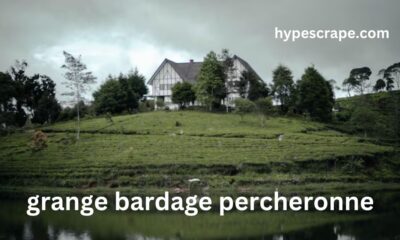BLOG
Mastering Motion with Active Camera in After Effects

In the world of digital design and animation, creating visually stunning and dynamic footage is a skill every designer covets. Adobe After Effects is a powerhouse for those looking to bring their creative visions to life through motion graphics and visual effects. Among its many features, the Active Camera function stands out as a crucial tool for adding depth and realism to your projects. This blog post is catered to designers and animators eager to explore the full potential of Active Camera in After Effects. We’ll guide you through understanding its functionality, share tips on enhancing your projects, and offer examples that illustrate its impact. Whether you’re a seasoned pro or just starting out, prepare to elevate your motion graphics game.
Understanding Active Camera in After Effects
When working in After Effects, the Active Camera view allows you to preview how your audience will perceive your final render. It’s not just a viewing option; it’s your gateway to achieving precise camera movements and angles. Mastering this feature can drastically improve the storytelling aspect of your animations. Understanding the nuances of how Active Camera in After Effects functions within the composition panel is essential for anyone serious about creating professional-level animations. It’s like having a director’s chair, guiding your audience’s eye to where you want them to focus while maintaining fluidity and perspective.
Why Active Camera in After Effects is Essential
Active Camera isn’t just a feature—it’s a necessity for adding realism to your projects. It simulates real-world camera movements, lending authenticity to your animations. When used effectively, it can make simple animations appear more complex and engaging. Designers often overlook the power of Active Camera in After Effects, focusing instead on individual element animation. However, integrating camera movements can transform an ordinary project into a cinematic experience, capturing the viewer’s attention and taking them on a visual journey. By harnessing the Active Camera, you’re not just creating animations; you’re crafting visual narratives.
Setting Up Your Active Camera in After Effects
Before you can start using Active Camera in After Effects effectively, proper setup is crucial. Begin by selecting the 3D Layer option for your elements to enable camera interaction. Navigate to the Layer > New > Camera path to create your camera and adjust its settings to suit your project needs. Understanding the basic parameters such as focal length, aperture, and depth of field will allow for more control over your scene. Taking time to set up your camera correctly lays the foundation for seamless animations and transitions, enabling you to achieve the desired cinematic effect.
Exploring Camera Tools and Shortcuts
Once your camera is set up, familiarize yourself with the various camera tools and shortcuts that After Effects offers. The unified camera tool (C key) allows you to switch between orbit, track XY, and track Z modes easily. Mastering these shortcuts can significantly speed up your workflow, allowing you to make swift adjustments without losing focus on your creative process. Understanding these tools is akin to learning to drive a new car; once you know how to control it, the road ahead becomes much smoother, enabling you to focus on the destination rather than the mechanics.
Creating Dynamic Camera Movements
Dynamic camera movements can add excitement and engagement to your animations. Experiment with pans, zooms, and rotations to see how they can transform static scenes. For instance, using subtle zoom-ins can emphasize particular elements, drawing the viewer’s attention precisely where you want it. To achieve this, combine keyframing techniques with the camera’s transform properties. By doing so, you create motion paths that can be adjusted to add or remove tension dynamically, making your project more visually appealing and narratively compelling.
Incorporating Depth with Active Camera in After Effects
The sense of depth in animations can be significantly enhanced with Active Camera in After Effects. By adjusting the camera’s depth of field, you can blur certain parts of the composition, guiding the viewer’s focus and creating a more immersive experience. This technique mimics how human eyes perceive the world, adding a layer of realism to your animations. It can be particularly effective in scenes with multiple layers, as it allows you to play with perspective and spatial relationships, giving your project a polished, professional feel.
Using Camera Layers for Complex Scenes
For more complex scenes, consider using multiple camera layers. This approach allows you to switch perspectives smoothly and can add a layer of sophistication to your work. By animating transitions between camera layers, you can mimic film techniques like cuts and fades seamlessly within your project. This method is particularly useful in storytelling, where maintaining narrative coherence through visual means is crucial. It not only enhances the viewer’s experience but also showcases your technical prowess as a designer.
Enhancing Storytelling with Camera Angles
Storytelling through animation benefits greatly from thoughtful camera angles. Consider the emotional impact of different angles—high angles can convey vulnerability, while low angles can instill power or dominance. By strategically choosing your camera’s position and angle, you can subtly influence the narrative tone and emotional response of your audience. This technique offers a powerful storytelling tool, allowing you to convey nuance and depth without relying solely on dialogue or overt action.
Examples of Effective Active Camera Use
To truly grasp the impact of Active Camera, examining real-world examples can be enlightening. Look at projects where subtle camera movements enhance the story, like in animated shorts or promotional videos. Notice how these projects use Active Camera in After Effects to guide the viewer’s eye, maintain interest, and convey complex emotions. Such examples provide inspiration and a benchmark for what’s achievable when incorporating Active Camera into your workflow, encouraging continuous learning and experimentation.
Troubleshooting Common Issues
Working with Active Camera can sometimes lead to unexpected challenges. Common issues include jerky movements, focus problems, or unexpected scene cutoffs. Troubleshooting these problems often involves revisiting your keyframes, checking camera settings, and ensuring no conflicting layers. Understanding how to diagnose and fix these issues will save time and help maintain project quality, ensuring that your final render meets both your professional standards and creative vision.
Staying Innovative with Camera Techniques
Innovation in camera techniques keeps your projects fresh and exciting. Stay updated with the latest trends and software updates to continually enhance your capabilities. Experimentation is key—don’t hesitate to try unconventional methods or mix different animation styles. By pushing the boundaries of what Active Camera in After Effects can do, you not only sharpen your skills but also contribute to the evolution of digital animation and design, staying ahead in a competitive industry.
The Future of Active Camera in Animation
Looking forward, the future of Active Camera in animation is promising. With advancements in AI and machine learning, future iterations of After Effects may offer even more intuitive and powerful camera controls. Staying informed about these developments ensures you remain at the forefront of your field, ready to leverage new tools and techniques to elevate your projects further. The potential for what you can create is limitless, limited only by your imagination and willingness to explore new frontiers.
Conclusion
Mastering the Active Camera in After Effects can transform your animations from ordinary to extraordinary. By understanding its functionality, exploring dynamic movements, and applying these insights creatively, you can create compelling visual stories that captivate and engage your audience. Whether you are just starting out or are looking to enhance your existing skills, the Active Camera offers a wealth of opportunities to innovate and excel in your craft. Continue to experiment, learn from each project, and most importantly, enjoy the creative process. If you’re ready to take your projects to the next level, start incorporating these techniques today and witness the transformation in your work.
BLOG
From Hometown Hero to Global Sensation: The Journey of Cori Castellano Irvington

Cori Castellano Irvington name is rapidly becoming synonymous with soccer excellence. From humble beginnings in Irvington to dazzling the world with his skills, Cori’s story is one of passion, perseverance, and prodigious talent. This blog post will take you through Cori’s inspiring journey, highlighting key milestones, challenges, and triumphs along the way. Whether you’re a die-hard soccer fan or simply someone who loves a good success story, this post will captivate and motivate you.
The Early Days in Irvington
Growing up in Irvington, Cori Castellano showed an early affinity for soccer. His passion was evident even as a child, kicking around a ball in his backyard. Encouraged by his supportive family, Cori joined local soccer clubs, where his talents began to shine. Coaches and peers quickly noticed his natural ability, predicting a bright future.
First Taste of Competition
Cori’s initial foray into competitive soccer was with Irvington Youth Soccer League (IYSL). Here, he honed his skills and developed a profound understanding of the game. It was during these formative years that Cori learned the value of teamwork and relentless practice, setting the foundation for his future success.
High School Highlights
Cori’s high school career at Irvington High was nothing short of spectacular. Playing for the school’s varsity soccer team, he led them to numerous victories, earning accolades and breaking records along the way. His remarkable performances caught the attention of college scouts and professional clubs, marking the beginning of his ascent to fame.
The College Soccer Scene
Opting to further his education while pursuing his soccer dreams, Cori Castellano Irvington attended a prestigious university known for its strong soccer program. Balancing academics and athletics was no small feat, but Cori managed it with aplomb. His collegiate career was decorated with awards and recognitions, solidifying his reputation as an exceptional player.
Overcoming Challenges
Cori’s rise wasn’t without obstacles. Injuries, rigorous training schedules, and the pressure to perform at a high level tested his resolve. However, Cori’s resilience and unwavering dedication saw him through these tough times. His ability to bounce back stronger from setbacks became one of his defining characteristics.
Entering the Professional Arena
Cori’s transition from collegiate soccer to the professional stage was seamless. Drafted by a major league soccer team, he quickly made a name for himself with his impressive debut performance. Fans and critics alike were in awe of his skill, agility, and tactical acumen.
International Stardom
Cori’s exceptional talent soon earned him a spot on the national team, taking his career to new heights. Representing his country in international tournaments, he showcased his abilities on the world stage, earning praise from global soccer icons and fans across the globe.
Training Regimen
Behind Cori’s success lies a rigorous training regimen. His daily routine includes intense physical workouts, technical drills, and mental conditioning. Cori’s commitment to maintaining peak physical and mental form is a testament to his professionalism and drive to excel.
Community Involvement
Despite his busy schedule, Cori remains deeply connected to his roots in Irvington. He frequently visits his hometown, participating in local events and inspiring young athletes. His involvement in community programs underscores his belief in giving back and nurturing future talents.
Inspirational Mentors
Throughout his career, Cori has been guided by several mentors who played pivotal roles in his development. Coaches, fellow players, and family members provided invaluable support and advice, helping shape Cori into the player and person he is today.
Future Aspirations
Looking ahead, Cori Castellano Irvington aims to continue pushing the boundaries of his potential. He dreams of leading his team to championship victories, breaking more records, and perhaps even transitioning into coaching or mentorship roles post-retirement. His ambition and vision for the future are as inspiring as his current achievements.
Impact on the Soccer World
Cori’s influence extends beyond just his on-field prowess. He is a role model for aspiring soccer players, demonstrating that with hard work and perseverance, dreams can indeed become reality. His sportsmanship and humility further endear him to fans and peers alike.
Personal Life
Off the field, Cori enjoys a balanced life filled with hobbies and interests that keep him grounded. Whether it’s spending time with family, engaging in community service, or exploring new cultures through travel, Cori values the experiences that enrich his life beyond soccer.
A Bright Future Ahead
Cori Castellano’s story is far from over. With each passing season, he continues to evolve and break new ground. His determination to achieve greatness while staying true to his values promises an exciting future for both him and his fans.
Conclusion
Cori Castellano Irvington is more than just a rising soccer star; he is an emblem of hard work, resilience, and community spirit. His incredible journey from Irvington to international fame serves as an inspiration to all, proving that with dedication and passion, anything is possible. Keep an eye on this phenomenal athlete as he continues to make waves in the soccer world. If you want to stay updated on his latest achievements or learn more about his training techniques, subscribe to our newsletter or follow us on social media.
BLOG
The Growing Role Of Massage Therapy In Holistic Wellness

What Is Holistic Wellness?
Holistic wellness is a comprehensive approach that focuses on nurturing the body, mind, and spirit as interconnected aspects of overall well-being. It emphasizes self-care, balanced nutrition, stress reduction, physical activity, and preventive practices to promote harmony. Increasingly, more people seek qualified therapists through programs like Find a Massage Therapist – AMTA or a massage therapy program Atlanta to achieve their wellness goals.
Holistic wellness has gained prominence in modern health culture over the past decade. As individuals shift away from quick fixes, they discover that integrating various health practices—such as nutrition, exercise, sleep, mindfulness, and bodywork—provides a more sustainable route to vitality. CNN emphasizes the importance of a personalized and comprehensive approach.
Massage Therapy Basics
Massage therapy is one of the oldest healing arts, involving manual manipulation of muscles, connective tissue, tendons, and ligaments by trained professionals. Techniques range from gentle Swedish massage for relaxation to deep tissue for chronic tension or injuries. Many use it regularly for health or to target specific issues. Its popularity grows due to versatility, fitting into holistic health, athletic support, or spa treatments, catering to diverse needs.
Physical Benefits Of Regular Massage
Regular massage sessions offer well-documented and far-reaching physical benefits. According to studies by the National Institutes of Health, massage therapy can help relieve chronic pain conditions, including lower back pain and arthritis. It works by increasing blood flow, relaxing tight muscles, and promoting the body’s natural healing processes. For athletes, desk workers, and those with physically demanding jobs, massage also plays a crucial preventive role, helping to reduce the risk of injuries, aiding muscle recovery, and improving range of motion and flexibility.
Mental And Emotional Benefits
Beyond the physical benefits, massage therapy is increasingly recognized for its impact on mental and emotional well-being. Physical touch from a trained therapist has been shown to lower stress hormones, such as cortisol, while enhancing the body’s levels of serotonin and dopamine—neurochemicals linked to happiness and relaxation. This makes massage an effective strategy for managing anxiety, depression, and work-related stress. Many people describe a sense of calm, clarity, and emotional balance after a session, which supports improved resilience and better coping strategies on a day-to-day basis.
How Massage Supports Overall Health
The best holistic practices recognize the interconnectedness of physical health, emotional well-being, and lifestyle. Massage therapy supports these links by helping regulate the nervous system, reducing inflammation, and boosting immune function. It can promote deeper, more restorative sleep, which is foundational for long-term health and healing. Within integrative medicine settings, massage is often used in conjunction with conventional treatments to support recovery from surgery or chronic illnesses, offering a non-pharmacological option for pain relief and enhancing quality of life.
Current Trends In Massage Therapy
The field of massage therapy continues to evolve as new evidence and approaches emerge. Recently, there has been a rise in therapy models that merge mindfulness and aromatherapy with massage for a richer, multi-sensory healing experience. Therapists are increasingly adopting trauma-informed and neuroscience-based techniques, reflecting the growing understanding of the mind-body connection. As reported by the New York Times, demand for well-trained massage therapists is higher than ever, due to both the mainstreaming of wellness and a greater appreciation for touch-based therapies.
Integrating Massage Into Daily Life
In busy modern life, integrating self-care can feel challenging, but massage therapy offers both structured and flexible options. Many individuals benefit from scheduling regular professional sessions, even 30-minute appointments, as a preventive measure for their wellness. At-home tools, such as foam rollers, massage balls, and guided self-massage techniques, are increasingly popular, allowing for daily upkeep between appointments. Combining therapeutic massage with gentle stretching, yoga, and mindful breathing can further amplify results, creating a complete at-home wellness regimen.
Finding Qualified Therapists
Choosing a licensed and highly trained massage therapist is crucial for safety and maximizing therapeutic benefit. Prospective clients should review the practitioner’s credentials, verify that therapists participate in continuing education, and seek reputable recommendations from healthcare professionals or trusted community members. Open communication about goals, preferences, and health history ensures a customized experience and fosters a trusting therapeutic relationship.
The role of massage therapy in holistic wellness continues to expand as individuals increasingly value integrated, evidence-based approaches to health. Whether part of a personal wellness routine or a professional care plan, massage offers profound and lasting benefits for both body and mind.
Conclusion: The Growing Role Of Massage Therapy In Holistic Wellness
Massage therapy has steadily moved beyond the realm of relaxation to become a cornerstone of holistic wellness. By addressing not only physical discomfort but also stress, circulation, and overall balance, it supports a healthier mind-body connection. As more people seek natural and preventative approaches to health, massage therapy stands out as both a therapeutic practice and a lifestyle choice. Whether used for recovery, stress relief, or ongoing wellness, its growing role highlights a shift toward embracing care that nurtures the whole person.
BLOG
Brass Step Lights: Elevate Your Home’s Elegance (Safely)

Introduction
You organize a summer dinner event for your guests under the warm light of evening. Guiding your visitors through the garden staircase, your guests witness the beautiful golden light spread from the sunset while the steps create the feeling of walking toward enchantment.
The lighting represents an experience that transcends typical illumination. Home design heroes brass step lights create safe and sophisticated illumination to turn regular areas into artistic showpieces.
You’ll discover complete details about how brass step lights transform your home’s visual appeal while making your property safer and more valuable throughout this authoritative piece. The roadmap in this article provides everything needed for selecting perfect fixtures in addition to installation and maintenance expertise, which will guide you towards creating a shining house both physically and metaphorically.
The Timeless Allure of Brass: A Legacy of Luxury
Brass offers more than metal properties since it serves as a material that tells historical narratives. Brass has existed for many centuries, and decorators have used it in temples and skyscrapers built during the Art Deco era. This golden coloration in brass creates a heritage feel that many architects and interior designers select for their projects.
- Historical Charm: Brass has continued to represent elegance in rooms since Victorian times and throughout mid-century modern properties. The creators used copper and brass to make the original torch of the Statue of Liberty due to their durability and reflective qualities.
- Design Chameleon: Brass integrates perfectly into current design styles without difficulty. The mixture of polished brass with marble creates a neoclassical atmosphere, and antique brass combined with reclaimed wood steers toward a farmhouse style.
- Durability Meets Beauty: Brass material develops historical charm through its natural patina growth, which leaves its structure unharmed and proud. Lacquer coatings applied today keep brass shiny outdoors by stopping water, salinity, and moisture from causing decay.
Why Brass for Step Lights?
The materials used for step lights must have both functional and visual qualities. Brass reflects light naturally to enhance LED illumination and supports heavy-weight distribution, which keeps fixtures stably positioned on floors. Brass occupies a perfect position between metals since it avoids both the icy quality of steel and the weak nature of plastic.
Safety First: How Brass Step Lights Protect and Beautify
The area right below and above the stairs proves to be one of the most dangerous zones in homes. The CDC states that annually, more than a million Americans sustain injuries because of stair-related incidents, which frequently happen because of inadequate lighting. Brass step lights resolve lighting problems in an elegant manner.
- Visibility Without Glare:
- Task Lighting Precision: Semi-ker lighting distributes illumination accurately toward stairs by eliminating dark shadows that overhead floodlights generate. Use lighting fixtures between 100 and 200 lumens, which illuminate edges without creating an excessive glare effect.
- Directional Beams: Select lights that have beam angles between 30 and 45 degrees to aim illumination effectively.
- Weatherproof Performance:
- IP Ratings Decoded: Lighting fixtures rated at IP65 protect against heavy rainfall as well as airborne dust, yet IP67-rated fixtures succeed under brief underwater submersion conditions (pool steps require this functionality). It is essential to confirm ratings before placing fixtures outside for installation.
- Temperature Resilience: Brass maintains its structure under extreme temperature conditions better than plastic since plastic tends to deform during hot or cold conditions.
- Child and Pet Safety:
- LED brass lights with 12–24 V low voltage maintain a temperature that avoids burns to users. The installation of these low-voltage LED brass lights (12–24 V) reduces the appeal of chewing while remaining cool to the touch.
Choosing Your Brass Step Lights: A Buyer’s Deep Dive
The market offers different types of brass step lights, which vary in quality. Learning to select brass step lights effectively follows these expert steps:
- Design Details That Matter
- Recessed vs. Surface-Mounted:
- Recessed: Flush with the step for a minimalist look. Ideal for high-traffic areas. These work beautifully when coordinated with other outdoor recessed lighting elements for a seamless look.
- Surface-Mounted: Project slightly for a more pronounced design statement.
- Finishes for Every Style:
- Polished Brass: Mirrored finish for formal entrances. Use black railings as contrasting elements to black railings.
- Antique Brass: Distressed finish with dark undertones. This color choice works ideally for cottage garden settings as well as Tudor-design homes.
- Brushed Brass: Matte texture that hides fingerprints. Great for modern decks.
- Recessed vs. Surface-Mounted:
- Lighting Technology Breakdown
- LEDs: The Modern Standard
- Color Temperature: 2700K (warm white) mimics candlelight; 3000K (soft white) offers a balance.
- CRI (Color Rendering Index): Use lighting fixtures with a CRI value higher than 80 to present accurate nighttime color representation of your home.
- Solar Power: Pros and Cons
- Pros: No wiring, eco-friendly, and portable.
- Cons: Marelli recommends operating under 6–8 hours of sunlight in sunny locations of the world. Select models that have backup battery options.
- For layered design, some homeowners complement step lighting with LED spotlights outdoor, providing focused beams for trees or garden features adjacent to stairways.
- LEDs: The Modern Standard
- Budgeting Smartly
- Entry-Level: $15–$30 per light (basic LEDs, surface-mounted).
- Mid-Range: $50-$100 (recessed, dimmable, with smart features).
- Luxury: $150+ (hand-forged brass, custom finishes, integrated motion sensors).
Installation Masterclass: From Novice to Pro
Whether you’re DIY-ing or hiring a pro, these tips ensure flawless results:
- Planning Like an Architect
- Step Mapping: Mark light positions by using chalk as a guideline. Stairway lighting should have installed fixtures on every second or third step. Pathways that require illumination should get mounted fixtures placed 18 to 24 inches away from each other.
The installation of lights must be performed at every second or third step for stairways. For long pathways, space them 18–24 inches apart. Thoughtfully placed pathway lighting enhances safety and sets the mood for night-time landscape journeys.
- Power Sources:
- Low-Voltage Transformers: Convert 120V household current to 12V for safer outdoor use. These systems are a cornerstone of modern outdoor low voltage lighting configurations.
- Solar Panel Placement: Placing solar panels in unobstructed southern positions will optimize their efficiency.
- Wiring Wisdom
- Concealing Wires: Cabling should sit at least 6 inches beneath the surface, while PVC tubes with painted matching colors can conceal wires.
- Connector Types:
- Waterproof Wire Nuts: For basic DIY connections.
- Solderless Snap Connectors: Faster and more reliable for beginners.
- Pro Tips for Tricky Surfaces
- Brick or Stone Steps: To anchor fixtures, you should use masonry drill bits along with anchors. The holes must be sealed with silicone to block moisture penetration. Silicone should be used to block holes and stop water leakage.
- Wooden Decking: Drilling pilot holes before screwing avoids fracture in the materials. Stainless steel screws resist rust.
- Smart Tech Integration
- Voice Control: The activation of brass step lights can be controlled by voice commands supported by Alexa and Google Home systems, so users can say, “Alexa, dim the patio lights to 50%.”
- Motion Sensors: The installation of adjustable sensors operating paths during needed occasions results in energy conservation.
If you’re unsure about DIY setup, consider hiring experienced outdoor lighting installers in Los Angeles to ensure compliance with local codes and a professional finish.
Maintenance: Preserving the Golden Glow
Proper care will make brass develop an attractive vintage appearance. These steps enable you to maintain spotless conditions for brass fixtures:
- Cleaning Rituals
- Weekly: A microfiber cloth should be used for dust removal once weekly.
- Monthly: To polish wood naturally, you should combine lemon juice (1 tablespoon) with baking soda (1 cup). Rinse thoroughly.
- Yearly: Each year, I use only items devoid of vinegar because acidity destroys metal elements, and I steer clear of salt-based cleaners because their basic nature accelerates deterioration.
- Combatting Patina
- Embrace It: Outdoor fixtures should naturally age by developing a greenish patina when left uncoated because it produces a vintage appearance.
- Prevent It: Regular application of automotive wax on lacquered brass surfaces is necessary for prevention twice a year.
- Seasonal Checkups
- Spring: Inspect for winter damage. Re-caulk around recessed lights.
- Fall: During the fall season, solar panels need to be cleared of tree leaves. Replace fading batteries.
Boosting Home Value: The ROI of Brass Step Lights
The property values can rise by a maximum of 20%, according to expert real estate analysis. The following benefits play a role when using brass step lights in home design:
- Curb Appeal Magic
- Homes listed with an “outdoor lighting” description in Zillow inventory typically sold at 32% above market valuation. Brass fixtures in outdoor lighting create a luxury signal that pulls high-profit buyers into the market.
- Outdoor Living Expansion
- A top landscape trend for 2024 involves outdoor “room” creation through step illumination and fire pit, and pathway lighting.
- Energy Efficiency Selling Point
- Add LED brass lighting fixtures to home listings when promoting properties through the internet. House buyers greatly appreciate home improvements that both cut electricity costs and reduce their environmental impact.
- In tandem, upgrades like LED garage lights enhance nighttime security while contributing to whole-home efficiency.
FAQs: Your Brass Step Light Queries, Answered
Q: Is it possible to install brass step lights for stairs featuring curved shapes?
A: Yes! The bending capacity of flexible LED strip lights comes from their brass channel housing.
Q: Do brass lights attract lightning?
A: Brass does not function as a lightning conductor except when properly connected to the earth.
Q: Are brass step lights compatible for combination with additional metal fixtures?
A: Absolutely. Brass aligns perfectly with matching metallic elements such as matte black and nickel-based material.
Conclusion
The unpretentious yet potent home design element that is brass step lights represents a quiet transformation. The dual benefit of brass step lights is that they provide both illumination for safety and enhance your home’s story through their sustainable artisanal quality.
When you choose these fixtures for staircases or paths, they will deliver eternal beauty regardless of their size.
Your task now is to visit a lighting showroom for direct viewing of brass-finish products. The gleaming brilliance of the metal surface catches your eye as if it serves as a warm invitation to your personal space. Then, leap. One golden step leads to the next by trying out a single fixture and testing different install locations.
-

 BLOG1 year ago
BLOG1 year agoEscape to Tranquility Experience Grange Bardage Percheronne in Normandy
-

 LIFESTYLE1 year ago
LIFESTYLE1 year agoAir Jordan 1 Retro High Off-White University Blue
-

 SOCIAL MEDIA1 year ago
SOCIAL MEDIA1 year agoDecoding the Drive Social Media Pyramid Scheme Mystery
-

 LIFESTYLE1 year ago
LIFESTYLE1 year agoAir Jordan 4 Retro Metallic Purple
-

 BLOG6 months ago
BLOG6 months agoDecoding 540-315-8592: From Numbers to Messages
-

 HOW-TO GUIDES1 year ago
HOW-TO GUIDES1 year agoShop Smart and Save with Goldengatemax.shop Online Guide
-

 BUSINESS1 year ago
BUSINESS1 year agoDemystifying 315-442-5267 Common Myths and Facts Revealed
-

 LIFESTYLE1 year ago
LIFESTYLE1 year agoAir Force 1 Shadow Pistachio Frost
